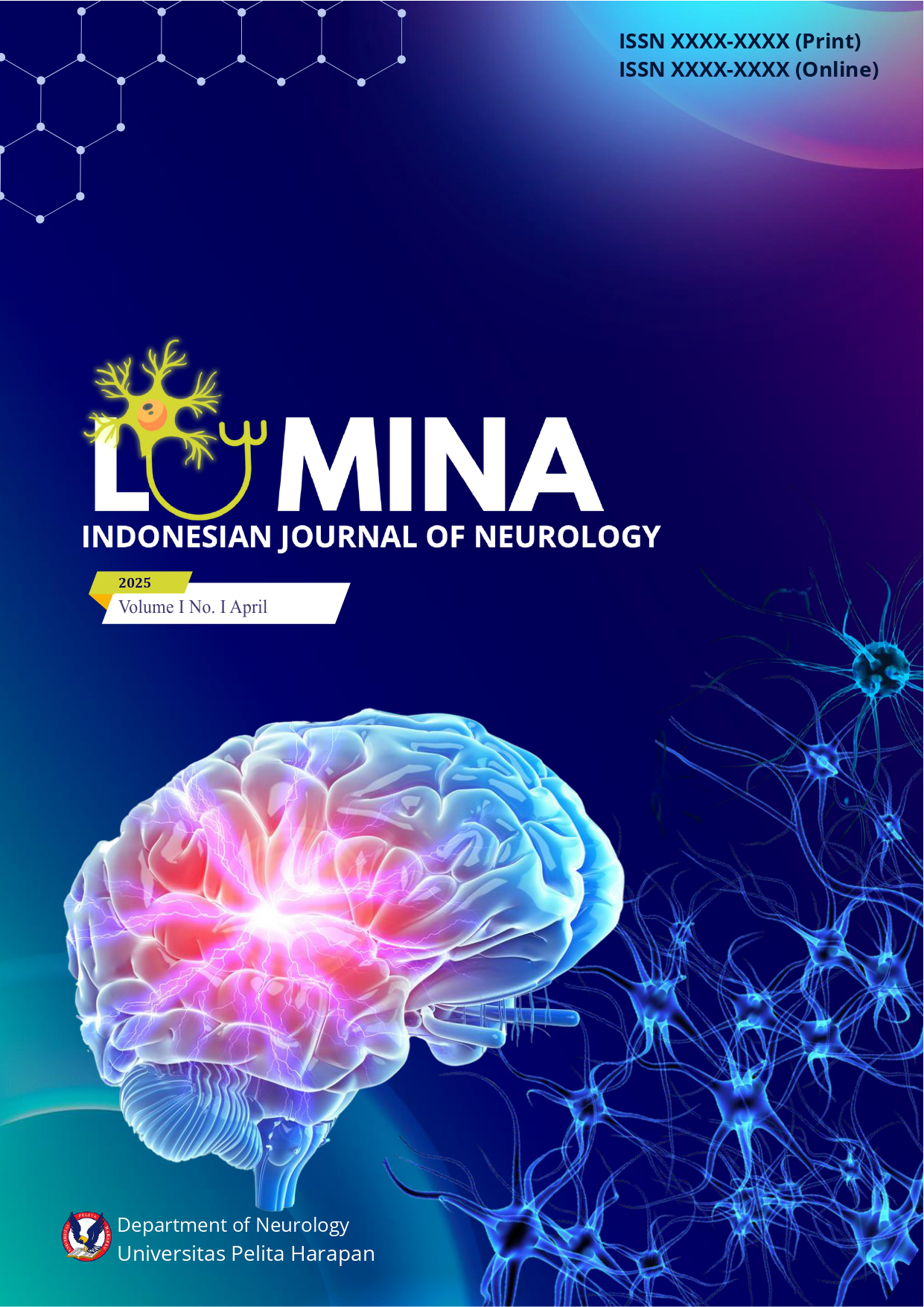Lactate Dehydrogenase as A Potential Prognostic Biomarker in Subarachnoid Haemorrhage: A Systematic Review
DOI:
https://doi.org/10.19166/lijn.v1i1.9861Keywords:
Lactate Dehydrogenase, Subarachnoid Haemorrhage, Prognosis, OutcomeAbstract
Background: Subarachnoid haemorrhage (SAH) lacks specific prognostic blood markers, but lactate dehydrogenase (LDH), linked to cellular damage, shows potential for predicting adverse outcomes in SAH patients. Elevated LDH levels may reflect anaerobic metabolism and tissue injury following SAH, providing insight into disease severity and complications. This review explores the relationship between lactate dehydrogenase levels and outcomes in SAH patients.
Method: A systematic review was conducted using PubMed, Europe PMC, ScienceDirect, and Google Scholar, searching for terms like "Lactate Dehydrogenase," "LDH," "Subarachnoid Haemorrhage," and "Outcome" up to March 3, 2025. Studies comparing LDH levels with Modified Rankin Score (mRS) and secondary outcomes such as Hunt-Hess grade, Fisher grade, complications, and mortality were included.
Result: Seven studies involving 5,985 participants met inclusion criteria. Higher LDH levels correlated with worse mRS scores, increased delayed cerebral ischemia (DCI), postoperative pneumonia, severe Hunt-Hess and Fisher grades, and higher mortality. Using the ROBINS-I tool, four studies showed low risk of bias, and three had moderate risk.
Discussion: Elevated LDH levels predict adverse outcomes in SAH, highlighting its prognostic value. As a marker of cellular damage and anaerobic metabolism, LDH reflects tissue injury and hypoxia post-SAH, explaining its link to complications like delayed cerebral ischemia (DCI) and pneumonia. This physiological basis supports its role in risk stratification, aiding early identification of high-risk patients for targeted interventions and improved outcomes.
Conclusion: Early measurement of LDH levels after SAH onset may help predict patient outcomes and complications, aiding clinical decision-making and improving patient management strategies.
References
1. Sanicola HW, Stewart CE, Luther P, et al. Pathophysiology, Management, and Therapeutics in Subarachnoid Haemorrhage and Delayed Cerebral Ischemia: An Overview. Pathophysiology. 2023;30(3):420-442. https://doi.org/10.3390/pathophysiology30030032
2. Sweeney K, Silver N, Javadpour M. Subarachnoid haemorrhage (spontaneous aneurysmal). BMJ Clin Evid. 2016; 2016:1213. https://pmc.ncbi.nlm.nih.gov/articles/PMC4794735/
3. Lv B, Lan JX, Si YF, et al. Epidemiological trends of subarachnoid haemorrhage at global, regional, and national level: a trend analysis study from 1990 to 2021. Military Medical Research. 2024;11(1):46. https://doi.org/10.1186/s40779-024-00551-6
4. de Winkel J, Cras TY, Dammers R, et al. Early predictors of functional outcome in poor-grade aneurysmal subarachnoid haemorrhage: a systematic review and meta-analysis. BMC Neurology. 2022;22(1):239. https://doi.org/10.1186/s12883-022-02734-x
5. Cavalli I, Stella C, Stoll T, et al. Serum LDH levels may predict poor neurological outcome after aneurysmal subarachnoid haemorrhage. BMC Neurology. 2023;23(1):228. https://doi.org/10.1186/s12883- 023-03282-8
6. Farhana A, Lappin SL. Biochemistry, Lactate Dehydrogenase. In: StatPearls. StatPearls Publishing; 2025. Accessed March 3, 2025. http://www.ncbi.nlm.nih.gov/books/NBK557536/
7. Zeng Y, Zhao Y, Dai S, et al. Impact of lactate dehydrogenase on prognosis of patients undergoing cardiac surgery. BMC Cardiovascular Disorders. 2022;22(1):404. https://doi.org/10.1186/s12872-022- 02848-7
8. Claps G, Faouzi S, Quidville V, et al. The multiple roles of LDH in cancer. Nat Rev Clin Oncol. 2022;19(12):749-762. https://doi.org/10.1038/s41571-022-00686-2
9. Ding CY, Peng L, Lin YX, Yu LH, Wang DL, Kang DZ. Elevated Lactate Dehydrogenase Level Predicts Postoperative Pneumonia in Patients with Aneurysmal Subarachnoid Haemorrhage. World Neurosurgery. 2019;129:e821-e830. https://doi.org/10.1016/j.wneu.2019.06.041
10. Anan M, Nagai Y, Fudaba H, Fujiki M. Lactate and Lactate Dehydrogenase in Cistern as Biomarkers of Early Brain Injury and Delayed Cerebral Ischemia of Subarachnoid Haemorrhage. Journal of Stroke and Cerebrovascular Diseases. 2020;29(5):104765. https://doi.org/10.1016/j.jstrokecerebrovasdis.2020.104765
11. Zheng S, Wang H, Chen G, et al. Higher Serum Levels of Lactate Dehydrogenase Before Microsurgery Predict Poor Outcome of Aneurysmal Subarachnoid Haemorrhage. Front Neurol. 2021;12:720574. https://doi.org/10.3389/fneur.2021.720574
12. Zheng S, Zhang Y, Wang H, et al. Serum Lactate Dehydrogenase to Phosphate Ratio as an Independent Predictor for Adverse Outcome of Microsurgical Clipping for Ruptured Intracranial Aneurysm: A Propensity-Score Matching Analysis. Brain Sci. 2022;12(6):737. https://doi.org/10.3390/brainsci12060737
13. Zan X, Deng H, Zhang Y, et al. Lactate dehydrogenase predicting mortality in patients with aneurysmal subarachnoid haemorrhage. Ann Clin Transl Neurol. 2022;9(10):1565-1573. https://doi.org/10.1002/acn3.51650
14. Ren J, Zhang C, Liu Y, et al. Prognostic value of initial routine laboratory blood tests in patients with aneurysmal subarachnoid haemorrhage requiring mechanical ventilation: a retrospective cohort study. J Thorac Dis. 2023;15(8):4413-4425. https://doi.org/10.21037/jtd-23-854
15. Hartings JA, York J, Carroll CP, et al. Subarachnoid blood acutely induces spreading depolarizations and early cortical infarction. Brain. 2017;140(10):2673-2690. https://doi.org/10.1093/brain/awx214
16. De Marchis GM, Filippi CG, Guo X, et al. Brain injury visible on early MRI after subarachnoid haemorrhage might predict neurological impairment and functional outcome. Neurocrit Care. 2015;22(1):74-81. https://doi.org/10.1007/s12028-014-0008-6
17. Friedrich V, Flores R, Sehba FA. Cell death starts early after subarachnoid haemorrhage. Neurosci Lett. 2012;512(1):6-11. https://doi.org/10.1016/j.neulet.2012.01.036
18. Hugelshofer M, Sikorski CM, Seule M, et al. Cell-Free Oxyhemoglobin in Cerebrospinal Fluid After Aneurysmal Subarachnoid Haemorrhage: Biomarker and Potential Therapeutic Target. World Neurosurg. 2018;120:e660-e666. https://doi.org/10.1016/j.wneu.2018.08.141
19. Zhou W, Mao Z, Wang Z, et al. Diagnostic and Predictive Value of Novel Inflammatory Markers of the Severity of Acute Traumatic Spinal Cord Injury: A Retrospective Study. World Neurosurg. 2023;171:e349-e354. https://doi.org/10.1016/j.wneu.2022.12.015
20. Ryu SY, Kleine CE, Hsiung JT, et al. Association of lactate dehydrogenase with mortality in incident hemodialysis patients. Nephrol Dial Transplant. 2021;36(4):704-712. https://doi.org/10.1093/ndt/gfaa277
21. Medina-Hernández EO, Pérez-Navarro LM, Hernández-Ruiz J, et al. Changes in Lactate Dehydrogenase on Admission Throughout the Covid-19 Pandemic and Possible Impacts on Prognostic Capability. Biomarkers in Medicine. 2022;16(14):1019-1028. https://doi.org/10.2217/bmm-2022-0364
22. Alonso-Bernáldez M, Cuevas-Sierra A, Micó V, et al. An Interplay between Oxidative Stress (Lactate Dehydrogenase) and Inflammation (Anisocytosis) Mediates COVID-19 Severity Defined by Routine Clinical Markers. Antioxidants. 2023;12(2):234. https://doi.org/10.3390/antiox12020234
23. Ho Kim J, Jun Yi H, Kim BT, Shin DS. Clinical relevance of serum procalcitonin in patients with aneurysmal subarachnoid haemorrhage. Exp Ther Med. 2022;24(5):653. https://doi.org/10.3892/etm.2022.11590
24. Li F, Zhang W, Hu H, Zhang Y, Huang D. Diagnostic value of procalcitonin, C-reactive protein and lactate dehydrogenase in paediatric malignant solid tumour concurrent with infection and tumour progression. Sci Rep. 2019;9(1):5903. https://doi.org/10.1038/s41598-019-42264-0





